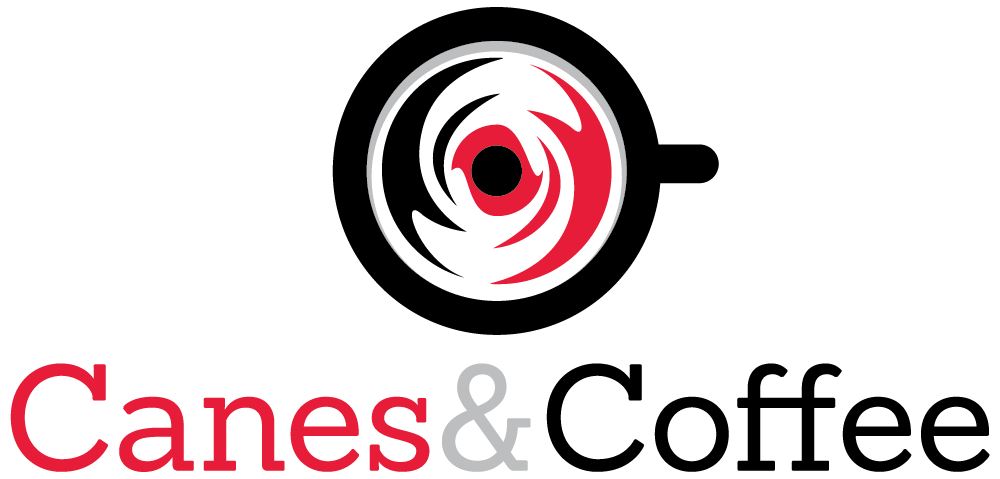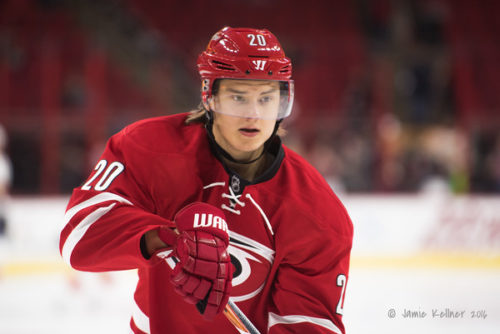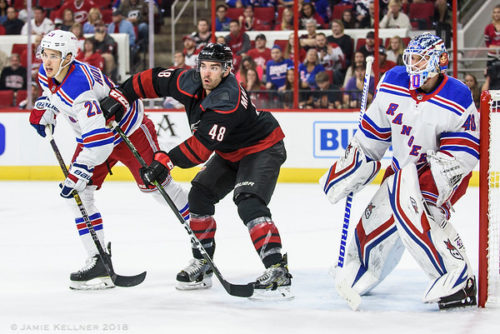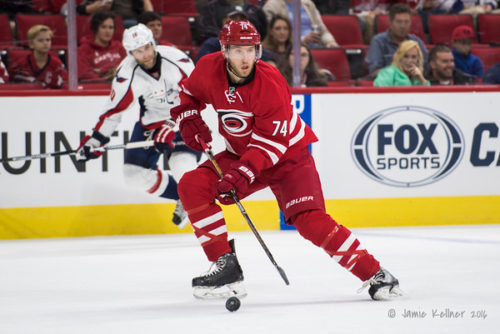With the Chicago Blackhawks scheduled to make their annual appearance at PNC Arena on Saturday, today’s Daily Cup of Joe will “go back to that same old place…Sweet Home Chicago.”
Few probably know that I am a native Chicagoan…sort of. I actually grew up in Northwest Indiana. There has always been a weird thing whereby anything west of Chicago and Illinois (regardless of if it was 110 miles away) was considered a Chicago suburb though anything across the Indiana line (despite often being 20-30 miles from the city limits) was not ever, under any circumstances considered a suburb. But I grew up watching the last three innings of the Chicago Cubs’ home games after school and full games after lunch in the summer on WGN BEFORE it was a cable station. And though anything food-related is obviously personal preference, I know my Chicago style pizza well enough to know respectable versions and also when someone horribly confused simple deep dish pizza with Chicago style. But alas, except for the coffee that sometimes fuels the site, Canes and Coffee is not a food site but rather a hockey site. So staying with Chicago, but back on the hockey thing…
The recent player pipeline from Chicago to Raleigh
The past few offseasons have seen a steady flow of former Chicago Blackhawk players make their way to Raleigh either directly or indirectly. I detailed the complete collection of nine former Blackhawks acquired by the Hurricanes in recent years in a guest article at The Loop Sports during the summer. (Six of those players are still on the Hurricanes roster.)
The player list includes Kris Versteeg, Viktor Stalberg and Bryan Bickell who are no longer with the Hurricanes and Klas Dahlbeck, Trevor van Riemsdyk, Joakim Nordstrom, Teuvo Teravainen, Marcus Kruger and Scott Darling who are still with the Hurricanes.
The alleged fleecing with Ron Francis taking advantage of Chicago’s salary cap woes
A key contributor to all of these moves has been Chicago’s perennial challenges to squeeze under the salary cap with their top-heavy salary structure and constant ability to manufacture more players who deserve raises.
The word on the street in Raleigh, North Carolina is that Ron Francis has been able to take advantage of Blackhawks General Manager Stan Bowman’s limited options and challenging financial situation. The word “fleeced” has been used on more than one occasion to describe Francis taking Chicago players for virtually nothing.
The final verdict on the whole thing cannot be rendered for at least a few years. As noted above the Hurricanes till have six former Blackhawks on their roster and are just transitioning from rebuilding to trying to win now. And Scott Darling who is arguably the former Blackhawk who will most determine the Hurricanes’ success in the coming years is only 13 games into his four-year contract with the Hurricanes.
So while any final verdict is premature, I think it is interesting to revisit the sequence of acquisitions and make an interim evaluation on what the Blackhawks maybe thought they were giving up and what Francis hoped he was receiving.
Did Stan Bowmanactually have it right?
Joakim Nordstrom and Kris Versteeg (Summer of 2015): The first salary cap deal between the Blackhawks and Hurricanes came just before the start of training camp before the 2015-16 season. The Hurricanes parted ways with only modest futures with a fifth-round pick being the biggest asset traded. (CORRECTION/NOTE ADDED: The Hurricanes actually received a third-round pick in this deal too, essentially getting paid to take salary/players. That makes the trade in terms of risk/reward even better at the time but does not change the interim November 2017 assessment that so far Bowman had it right in terms who he chose to part with.) At the time, the deal looked like a steal for the Hurricanes. Bowman had to part ways with someone to get under the salary cap ceiling before training camp, and Kris Versteeg and his $2.5 million contract were the casualty. With Nordstrom reasonably likely to see waivers, he was included too. On a Hurricanes team that was still incredibly light on forward depth, both players hopped right into key roles. Versteeg eventually found himself on the Hurricanes’ top line with Eric Staal and Nordstrom played his way up to the second line with Jordan Staal. Based on where the players slotted, the deal looked like a landslide win for Ron Francis. And while the two players did help fill holes in the lineup for cheap, I actually think Stan Bowman had this deal about right. Nordstrom has since proven to be a decent but by no means irreplaceable fourth-liner, and Versteeg is at best a top 9 depth forward also of the variety that is replaced by youth on deep teams.
In the end, the first deal was not a bad one for Ron Francis. How could it be? He really did not give up anything of significance in the trade. But when you net it out, all Francis really acquired were two replacement level players who were not significantly better than what is available for free on the free agent market. A data point that reinforces this point is that Versteeg was more or less replaced by a similar veteran at the same price in Lee Stempniak who came off the free agent market. And I would loosely put Nordstrom in the same category as VIktor Stalberg (last summer) and Josh Jooris (this summer) who were acquired via free agency to fill a fourth line role for a modest cost. Shorter version is that it is not clear that Versteeg or Nordstrom from the first deal really turned out to be more than could have been obtained on the free agent market for free.
Teuvo Teravainen and Bryan Bickell (Summer of 2016): Returning to the well and again providing salary cap relief as a service (SCRAAS), Francis pulled off an even bigger deal early in the summer of 2016. In return for taking on Bryan Bickell and his $4.5 million salary cap hit, Francis received young but NHL-experienced Teuvo Teravainen. At the time, the deal looked like a tremendous deal for Francis. Teravainen was only 21 years old but with 102 games of NHL experience, first-round draft pedigree and alleged offensive upside. He had yet to establish himself as a true offensive talent at the NHL level, but the potential was there. On the Hurricanes side, the hope was that he would progress to become a top 6 scoring type in the next couple of years. On the Blackhawks side, Teravainen had been surpassed by Artemi Panarin who rose up from nowhere and due to Panarin and also Teravainen’s inconsistency, Teravainen had been most relegated to a third line/depth role down the stretch of the 2015-16 season.
If you fast forward two years later, I think the Chicago version of the story again wins the vote. Now two years later, Teravainen is still pretty much the same as when he packed up and left the Windy City. He shows flashes of having the skill to be a higher-end scorer, but the reality is that the top 6 scoring version of Teravainen still shows up only intermittently such that he is still only a top 9 depth scorer without any semblance of game to game consistency.
Teravainen is only 23 years old, so the final chapter of his NHL story is far from written, but as of November 10, 2017, I think Stan Bowman again had it about right. With a few different options for how to cut salary, he made a somewhat risky call that Teuvo Teravainen would not become more than offensive depth. Thus far, Bowman has nailed this one too.
Klas Dahlbeck: Dahlbeck came to the Hurricanes indirectly after a stop in Arizona. At one point, it seemed odd that the Blackhawks would let a young defenseman potentially with upside slip away. But again, Bowman had it right. Dahlbeck continues to collect NHL experience, but the prospect of him becoming more than a serviceable #6/#7 defenseman is decreasing not increasing with each day that passes. To be clear, Francis acquired Dahlbeck only as emergency and free blue line depth off waivers, but I still think this is another example of Bowman correctly evaluating a young player with upside and making a decision that he would not reach it.
Marcus Kruger: Kruger is another that took an indirect path out of Chicago before ultimately arriving in Raleigh. Obtaining a player who was a third-line center on a championship team only a few years ago for merely a fifth-round pick seemed to be a steal. Kruger has settled nicely into a fourth-line role. Pending the usual solidifying of Steve Smith’s penalty kill as the season wears on, Kruger has been a good acquisition so far. But as with the other former Blackhawks, it is about role, upside and Bowman’s personnel assessment being mostly on target. Yes, Marcus Kruger played a vital third-line checking role on good Chicago teams, but it was within a structure that had two top heavy scoring lines and really needed only a good checking line center for the third line. Kruger’s one point in 13 games and eye test that mostly matches suggest that Bowman again had it right pegging Kruger as a good, but fairly limited player (somewhat like Nordstrom actually) who was expendable once salary necessitated it.
Trevor van Riemsdyk: When the Blackhawks were healthy, van Riemsdyk slotted into the third pairing, but the Blackhawks were banged up on the blue line in 2016-17 which afforded van Riemsdyk a couple opportunities to play in a top 4 role. When the Hurricanes acquired van Riemsdyk, I checked in with a couple people who track the Blackhawks on a game by game basis, and the unanimous report was that van Riemsdyk was a decent puck-moving #5 or #6 defenseman but had yet to prove capable of being more than that.
Important to note is that Francis obtained van Riemsdyk for exactly that role and thus far he is playing well in that role and also providing support for rookie Haydn Fleury as he transitions to the NHL level. So while this is by no means a miss by Francis, I think it is fair to say that Bowman just might have again assessed a young player with potential upside and been correct that it might not be realized.
The last hope?
That leaves the player who arguably could have as much say in the Hurricanes neart-term future as any former Blackhawk and maybe even any player on the current roster – Scott Darling.
Again, this is not completely the case of Stan Bowman deciding if he wanted to or did not want to keep a player. With Darling coming off a strong season and having a claim to a starter’s role somewhere, there really was nothing Bowman could do to make the math work to keep Darling short of trading Corey Crawford which was not happening.
That said, he does represent another case of a player who looked pretty good in Chicago and departed with upside potential.
Will Scott Darling prove to be the one player that Stan Bowman parted ways with who realizes his upside and makes at least some element of the ‘fleecing’ claims accurate in the near future? We, as Hurricanes fans, will watch it play out of the next four years.
Other Stan Bowman notes
By no means has Bowman been perfect, but in a financial situation that has forced him to shed significant players on a yearly basis simply because of salary cap issues, I think his track record on non-Canes losses is also pretty good.
The list of players who were better wearing a Blackhawks jersey than they were after departing is a huge one. All of Dave Bolland, Troy Brouwer, Brian Campbell, Patrick Sharp, Johnny Oduya, Andrew Shaw, Antti Niemi and others were better in a Blackhawks jersey than they were after they departed. Bowman sold high on Brandon Saad and then managed to get him back and managed to fill holes left by the departure of Dustin Byfuglien, Andrew Ladd, Nick Leddy and others.
Considering the volume of tough calls Bowman has had to make on keeping versus parting ways with productive players, I would say his track record is pretty good and also that betting against his player assessments has met with many more losers than winners.
What say you Canes fans?
1) Has Stan Bowman just been fortunate, or does he deserve some credit for his ability to assess players’ futures?
2) Closer to home, will Scott Darling prove to be the big one that got away from Chicago and also a key part of the Hurricanes return to the playoffs? Or is there a chance that Bowman had this one right too?
Go Canes!




Matt – this has to be the most disappointing and “let’s look at the dark side” artcile I have seen you write here. Honestly, it is so poor that I think it is time for me to take a break from Canes & Coffee for a bit.
There are ways to respectfully disagree without making such a comment. Please consider articulating a contrary opinion, as many regular readers do from time to time, if you have one.
Well, thank you for that suggestion. I will certainly consider it, as you suggest.
At the same point in time I will comment as I see fit, whensoever I may see fit. As I have in the past. I have provided money to this site previsouly – as I am sure you have too, yes???
Matt, you may be right about Bowman but I wonder if you’re being unfair to Ron.
First off these were easy risks for him to take, and none of them, save Dahlbeck, has actually been BAD.
Secondly, Ron turned Versteeg into Zykov. And even if Zykov isn’t a known quantity, we still didn’t give up jack for any of it.
Bowman built a bit of a dynasty there in Chicago, I’m not shocked that he’s a good GM.
I agree there is too much darkness right now, this is not a bad Canes team by any means. Slow-starting yes, but that’s not exactly abnormal.
Both general managers made out in these deals. Francis was able to up the talent level both in the short term (Kristeeg) and longer term (Teravainen) without giving up much of anything. The others were all targeted depth players that again were obtained by not much more than helping Chicago get out of salary cap jams. I look at this as two gms having a good relationship and able to deal above board so that both teams benefit. You can’t say from the Canes perspective that any of the deals were bad. All good, solid hockey trades that in one way or another, have helped the Canes get to the point of even talking about making the playoffs, something which the Hawks take for granted every season.
I agree that the comments that these deals were not bad for the Canes/Francis. In crediting Bowman and reassessing just how good they were, I did not mean to say that they were. I actually think all of the deals were smart in that they either helped fill short-term gaps for next to nothing or offered high potential upside for very little cost.
But I think the general impression in the Canes community that the Hurricanes have fleeced the Blackhawks in these trades has yet to pan out. As noted in the front of the article, a number of things are still pending and could swing the ultimate outcome.
And for those who have shipped me off to the dark side, I did vote ‘half full’ in yesterday’s poll. 🙂
I think there’s some truth to both sentiments. Similar to tenininumee, I think the deals were fair for both sides.
GMRF got good value considering what he gave up. Mid to late round picks and temporary cap hits when the team had (has) the room made sense, and it’s fair to say that none of the deals hurt the team.
On the flip side, I also think it’s fair to say that none of these deals have knocked it out of the park, at least not yet.
I’ve been particularly critical of Teravinen in the past. I think Bowman made the right gamble there. Maybe with additional supporting talent making room he will flourish, but as of now I view him as supplemental scoring depth as well, and not a “difference maker” on his own. Maybe he’ll find another gear this year, he absolutely has the talent; I think it’s a level of physicality that he’s missing.
Darling is really the player that could change the balance one way or the other. I didn’t expect him to play lights out, but I am hoping for a modest improvement over his average performance to date. To be fair, it does take some time to get used to a new system and defense, no matter how much talent you have. Plus, and I mean no disrespect – the Canes are not the Blackhawks… though we are all hoping that changes in the next couple years.
To againstthegrain’s point, I just had a different discussion that more less said that the Scott Darling ultimately decides if the player pipeline from Chicago to Raleigh boosted the Canes to a higher level or just helped fill holes during the rebuilding process. Teravainen is the other wild card who still has the same potential upside that he arrived with but has yet to really reach it on an every game or even most game basis.
You know this is a fascinating point. I’m rooting for Darling hard, but I think you really do have a handle on the situation. I wish I could give Teravainen more love, and a 40 point scorer isn’t bad by any means, but 50 would be nicer.
Hey guys, don’t throw Matt under the bus for telling it like it is!
The POLLYANNA view of the Canes…just doesn’t jibe with the facts and situation! The reality of the skills mentioned by Matt is spot on. None of these guys have been surprisingly better than expected.
Darling may be the best, but we already knew that Bowman had little choice in that deal. Most of Matt’s half-full views have been a trifle optimistic IMO, BUT…come on, THERE IS NO WAY HE IS CLOSE TO BEING ON THE DARK SIDE! I’m hoping (if things don’t change), he comes closer to my DARKER (more realistic) view! …soon!
If facts change (and this team actually plays well (more than one game)…I’d be happy to change my negative view…but…I’ll be shocked, under the circumstances…!
Puckgod, it does jibe with the facts though. Statistics are facts. The STATISTICS (e.g. facts) are that we’re still off to our best start points-wise in five years. Are we where we need to be? Clearly not, but its not like we’re way off the path.
Let’s look at this clamoring for a star that you think will put us over. Well there is one team that has a ridiculous amount of star-power and yet has played more games than us and scored the exact same amount of goals. You know who that team is? Freaking EDMONTON. Do they not have a top-line scorer? Is McDavid an overrated B-player?
The facts are that we are exactly who we were supposed to be. A young team with a promising defense that might be streaky and struggle to score. We’re going to get hot and make a run. You know how I know that? Because we’ve done it every year for the last three years. The difference is we’re in a better spot now, then we have been for any of those runs. I’ll go back to my opposite end of the fan spectrum now.
RE: Edmonton. Look at the challenges they face with the salary cap. Draisaitl has a $8.5 cap hit, RNH $6 and Lucic $6 mil each plus Conner McDavid and his billion dollar slice of the cap. Have fun building a solid team around that group and making the salary structure work. Building a solid, young team on relatively inexpensive contracts is the way to go, assuming you draft well and make smart trades to build depth. Francis has done that. However, at some point you need that difference maker to get over the top. That’s where I believe the Canes will be at the end of this season and it will be that move that will ultimately define Francis’s legacy in Raleigh.
^Testify!^
From Chicago or elsewhere, I’m always disappointed when they fill out the roster with “bargains” right before the season starts, shutting the door for hopefuls in the system. Only one spot was left open this year, a D spot for Fleury. Now that Charlotte is busting at the seams, I expect to see AHL promotions next season.
Perspective…. write this article after a win streak and it looks different. Still way to early to tell….
It will be a challenging couple of nights coming up. Going into Columbus and getting a win against a real solid team and turning around and beating a rested, desperate Hawks team would be a nice way to calm the masses. A couple of losses, even if they play well, will obviously have the opposite effect. These are a couple of pretty big games in my view.
Completely agree in both respects. I noted the “too early to tell” by calling this an interim assessment.
As far as the perspective based on win streak, winning solves everything. If Canes make playoffs and push couple rounds deep, nitpicking how much each of the former Blackhawks players contributed will be irrelevant minutiae as we celebrate the progress.
Bowman is an outstanding GM. The Hawk’s record is testimony to that fact. Francis is an unknown quantity as GM up to this date. So far, Francis does NOT have much to show for all his moves other than a bunch of PROSPECTS at Charlotte. So far the talent he has obtained through trades has been less than mediocre. Darling is his latest attempt at getting a blue chip player. I think he has one here it Peters doesn’t kill him so he can play his boy Wardo.